|  | | | |  an earlier volume of the annual anthology where Jackson’s story appeared an earlier volume of the annual anthology where Jackson’s story appeared | | “Millennium”
by Ruth Jackson
First publication: Anthology of Best Short Short Stories, Volume 7, 1959

While on a walk a few days before Christmas, Bill Ebberly has a dizzy spell and momentarily finds himself millennia in the future where he learns that the world has outgrown the need for hospitals and police.

Parts of this story had the tenor of a Jack Finney story, but the characters and plot did not generate the interest that Finney’s can. You know, you have touched upon a train of thought that has always interested me—our sense of time. Time, as we know it, is only an objective concept, like a sense of color. We here upon this earth are moving upon a plane and recognize as really existing only the small circle lighted by our consciousness, one meridian. That which is behind has disappeared and that which is ahead has not yet appeared, so we say that they do not exist. You know, you have touched upon a train of thought that has always interested me—our sense of time. Time, as we know it, is only an objective concept, like a sense of color. We here upon this earth are moving upon a plane and recognize as really existing only the small circle lighted by our consciousness, one meridian. That which is behind has disappeared and that which is ahead has not yet appeared, so we say that they do not exist. 
| |
| | | | |

 
 
 | | | |  The story also appeared in this 2003 collection. The story also appeared in this 2003 collection. | | “The Willow Tree”
by Jane Rice
First publication: The Magazine of Fantasy and Science Fiction, Feb 1959

By my count, this is the fifth time travel story in the February 1959 issue of F&SF, which is a record. Maybe they were anticipating the release of The Time Machine in the subsequent year.

In this story, four orphans are sent to live in the past with the rather odd Aunt Martha and the slightly less odd Aunt Harriet, who together give the children only one commandment: Never play under the willow tree! When the four O When the four O :: children, Lucy, Robert, Charles, and May, were orphaned by a freak of circumstances, they were sent to live in the Past with two spinster relatives, ostensibly because of crowded conditions elsewhere. 
| |
| | | | |

 
 
 
 | | | | 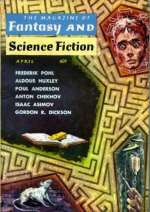

| | “Unto the Fourth Generation”
by Isaac Asimov
First publication: The Magazine of Fantasy and Science Fiction, Apr 1959

During an ordinary day of business, Sam Marten is obsessivly drawn to different men named Levkowich, each with a different spelling.

When I began putting together this Big List in 2005, I started with all the Asimov time travel stories that I could remember. Somehow I forgot about this story which I first read in 1973 in Nightfall and Other Stories. But then, while scouring the 1950s back issues of F&SF for more obscure stories, there it was: Sam Marten’s great, great grandfather brought from his deathbed to meet Sam, and there, also, was a moment of time travel for Sam himself.

Two new sentences were added at the end of the original story for the reprinting in Asimov’s collection, so I thought it would be appropriate to quote those new sentences here: Yet somehow he knew that all would be well with him. Somehow, as never before, he knew. Yet somehow he knew that all would be well with him. Somehow, as never before, he knew. 
| |
| | | | |

 
 | | | | 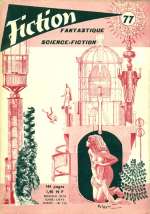 The story also appeared in the Apr 1960 issue of this French story magazine. The story also appeared in the Apr 1960 issue of this French story magazine. | | “Tenth Time Around”
by J.T. McIntosh
First publication: The Magazine of Fantasy and Science Fiction, May 1959

 Gene Player seems destined to always lose his love Belinda to his friend Harry Scott, but maybe, just maybe, he’ll get it right on the tenth time around as he’s once again sent back to his 1975 body in this branching universe time travel story. But what if in the new 1975, he meets young Doreen for the first time, not to mention those other small things that go differently? Gene Player seems destined to always lose his love Belinda to his friend Harry Scott, but maybe, just maybe, he’ll get it right on the tenth time around as he’s once again sent back to his 1975 body in this branching universe time travel story. But what if in the new 1975, he meets young Doreen for the first time, not to mention those other small things that go differently? It was a big decision, the first time. If you were at all successful in life at forty, fifty, sixth, the glorious thought of being young again, strong, healthy and probably in love, was considerably tempered by the consideration that you’d be pushed around again, that you’d have to get up at seven and work hard all day for less than a tenth of what you made now, that you’d have to go through this or that operation again, that you’d have to see your father and mother die again . . . It was a big decision, the first time. If you were at all successful in life at forty, fifty, sixth, the glorious thought of being young again, strong, healthy and probably in love, was considerably tempered by the consideration that you’d be pushed around again, that you’d have to get up at seven and work hard all day for less than a tenth of what you made now, that you’d have to go through this or that operation again, that you’d have to see your father and mother die again . . . 
| |
| | | | |

 
 
 | | | | 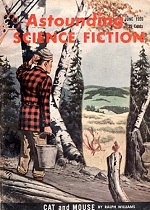

| | “Unborn Tomorrow”
by Mack Reynolds
First publication: Astounding, Jun 1959

Private investigator Simon and his assistant Betty are hired by a curious old man to hunt up some time travelers at Oktoberfest. Betty is game, but Simon, sporting a major hangover, is uncharacteristically reticent. “Time travel is impossible.” “Time travel is impossible.”
 “Why?” “Why?”
 “Why?” “Why?”
 “Yes, why?” “Yes, why?”
 Betty looked to her boss for assistance. None was forthcoming. There ought to be some very quick, positive, definite answer. She said, “Well, for one thing, paradox. Suppose you had a time machine and traveled back a hundred years or so and killed your own great-grandfather. Then how could you ever be born?” Betty looked to her boss for assistance. None was forthcoming. There ought to be some very quick, positive, definite answer. She said, “Well, for one thing, paradox. Suppose you had a time machine and traveled back a hundred years or so and killed your own great-grandfather. Then how could you ever be born?”
 “Confound it if I know,” the little fellow growled. “How?” “Confound it if I know,” the little fellow growled. “How?” 
| |
| | | | |

 
 
 
 | | | | 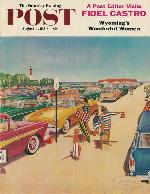

| | “The Love Letter”
by Jack Finney
First publication: The Saturday Evening Post, 1 Aug 1959

A young man looking for love in 1959 Brooklyn finds and answers a letter from a young woman in 1869 Brooklyn. The folded paper opened stiffly, the crease permanent with age, and even before I saw the date I knew this letter was old. The handwriting was obviously feminine, and beautifully clear—it’s called Spencerian, isn’t it?—the letters perfectly formed and very ornate, the capitals especially being a whirl of dainty curlicues. The ink was rust-black, the date at the top of the page was May 14, 1882, and reading it, I saw that it was a love letter. The folded paper opened stiffly, the crease permanent with age, and even before I saw the date I knew this letter was old. The handwriting was obviously feminine, and beautifully clear—it’s called Spencerian, isn’t it?—the letters perfectly formed and very ornate, the capitals especially being a whirl of dainty curlicues. The ink was rust-black, the date at the top of the page was May 14, 1882, and reading it, I saw that it was a love letter. 
| |
| | | | |

 
 
 
 | | | | 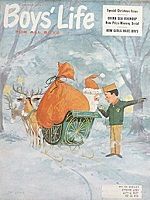

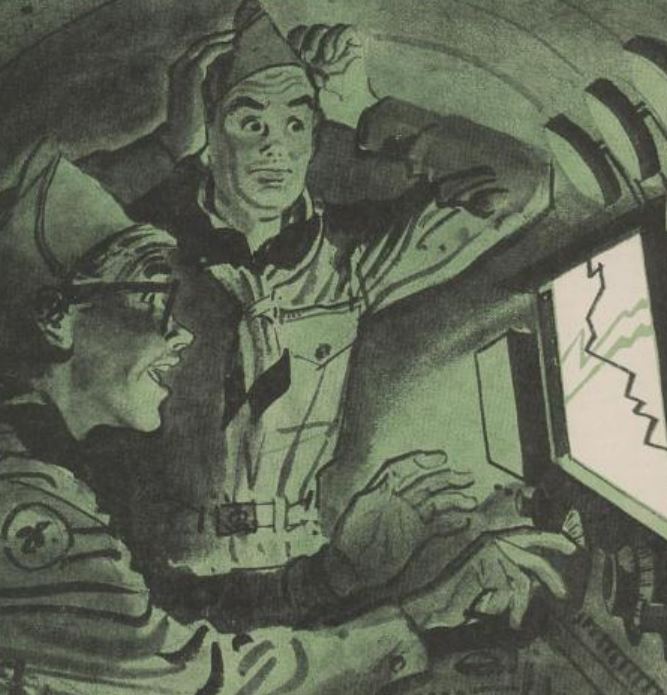

| | The Boys’ Life Time Machine Stories
by Donald Keith (aka Donald and Keith Monroe)
First story: Boys’ Life, Dec 1959

Boy Scout Bob “Tuck” Tucker, of the Polaris Patrol, doesn’t want to look after tag-along Elsworth “Brains” Baynes, but he does so as a favor to his father. Then one day near the scout camp, they find a time machine that lets them explore history with a bit of science fiction (people have no hair or teeth in the future) thrown in on the side. Later in the series, they’re joined by Kai from the city of Troy in the year 4000 and Dion from ancient Sparta.

Some of the stories were gathered into two collections: Mutiny in the Time Machine (1963) and Time Machine to the Rescue (1967).- The Day We Explored the Future (Dec 1959) finding the machine
- The Time Machine Flies Backwards (Feb 1960) back to Teddy Roosevelt
- How We Got the Mind-Reading Pills (Jun 1960) to future to rescue Kai Bezzy
- Our Time Machine at the Jamboree (Jul 1960) to ancient Sparta to get Dion
- Marco Polo and Our Time Machine (Oct 1961) to Marco Polo’s China
- The Time Machine Slips a Cog (Feb 1962) accidental trip to 1972
- Mutiny in the Time Machine (Dec'62-Mar'63) Pre-Columbian America
- The Time Machine Cracks a Safe (Jun 1964) to rescue Kai’s parents
- Time Machine to the Rescue (Oct 1964) rescue the parents again!
- The Time Machine Gets Stuck (Feb-Apr 1965)) to Maximilian I
- Time Machine Hunts a Treasure (Apr-Jun 1967) diary investigation in 1900
- The Dog from the Time Machine (Dec 1968) briefly to 1473 with wolf-dog
- Time Machine and the Generation Gap (Sep 1970) underwater in 2020
- The King and the Time Machine (Aug 1971) Edward III to far future
- The Time Machine Cleans Up (Feb 1973) recycler from the future
- The Time Machine Twins the Jamboree (Aug 1973) visit two places at once
- Santa Claus and the Time Machine (Dec 1973) put together a Santa Claus
- The Time Machine Fights Earthquakes (Nov 1974) visit to past/future quakes
- The Time Machine Saves a Patriot (Apr 1975) to Paul Revere
- The Time Machine Kidnaps a Parade (Jul 1976) Colonial soldiers to today
- Target Timbuktu (Sep 1988) to ancient Africa
- Why We Kidnapped Our Scoutmaster (Feb 1989) an 1850s mountain man
- Pirates Took Our Time Machine (Sep 1989) pirates in 1731
 One little egghead reached out, kind of scared, and gave my hair a nasty tug. “Mullo,” the Scoutmaster said sharply. “Jog law six. A Scout is kind. He is warmheart to animals. He nul kills or pangs any living creature for trivia.” One little egghead reached out, kind of scared, and gave my hair a nasty tug. “Mullo,” the Scoutmaster said sharply. “Jog law six. A Scout is kind. He is warmheart to animals. He nul kills or pangs any living creature for trivia.”
 Their words for the sixth Scout Law were weird, but I was glad to know they still had the law, especially if they thought I was an animal. Their words for the sixth Scout Law were weird, but I was glad to know they still had the law, especially if they thought I was an animal. 

—“The Day We Explored the Future”
| |
| | | | |

No Time Travel. Move along. |
Tales of Magic #5: Magic or Not? by Edward Eager, Feb 1959 [no time travel ]

| |     |